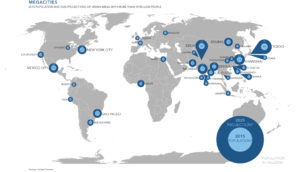Building the Largest Cities in Human History
Megacities are metropolitan areas with greater than 10 million inhabitants. There were 2 megacities in 1950. As of 2015, there are between 29 and 35, depending on how different census bodies count the geographical boundaries of cities. Major population forecasters project that by 2030, there will be 41 to 53 megacities in the world. Asia alone is anticipated to have 30 megacities by 2025.
The megacity phenomenon is a subset of the larger trend towards urbanization. The world is urbanizing at a greater rate than at any time in history. Just 3% of the global population lived in cities in 1800. As of 2014, over half of all people live in cities. Demographics experts anticipate that figure to increase to two-thirds by 2030-2050.
Megacities are extremely productive from an economic standpoint, and this encourages greater and greater migration. Megacities are estimated to have generated 14.6% of global GDP in 2010, a figure that has grown and will continue to grow.
These cities are extremely complex, bringing a host of transportation, infrastructure, health, and sustainability issues, which magnify at scale. Accordingly, they provide a series of unique risks and opportunities for companies and public officials. These challenges are often exacerbated by extreme rates of growth in some regions. Lagos, Nigeria, for example, has grown from 300,000 inhabitants in 1950 to 15.2 million today, a population explosion that magnifies many of the transportation, sanitation, and sustainability issues that all megacities grapple with.
Largest Megacities (2015)
| City | Population (millions) | Population Density (people per square km) |
|---|---|---|
| Tokyo-Yokohama, Japan | 37.8 | 4,400 |
| Jakarta, Indonesia | 30.5 | 9,500 |
| Delhi, India | 24.9 | 12,100 |
| Manilla, Philippines | 24.1 | 15,300 |
| Seoul-Incheon, South Korea | 23.48 | 10,400 |
| Shanghai, China | 23.41 | 6,100 |
| Karachi, Pakistan | 22.1 | 23,400 |
| Beijing, China | 21 | 5,500 |
| New York, United States | 20.6 | 1,800 |
| Guangzhou-Foshan | 20.5 | 6,000 |
| Sao Paulo, Brazil | 20.3 | 7,500 |
| Mexico City, Mexico | 19.4 | 8,800 |
| Mumbai, India | 17.7 | 32,400 |
| Osaka-Kobe-Kyoto, Japan | 17.4 | 5,400 |
| Moscow, Russia | 16.1 | 3,500 |
| Dhaka, Bangladesh | 15.66 | 43,500 |
| Cairo, Egypt | 15.6 | 8,900 |
| Los Angeles, United States | 15 | 2,400 |
| Bangkok, Thailand | 14.9 | 5,800 |
| Kolkata, India | 14.6 | 12,200 |
Source: Reuters
Challenge and Opportunity
The size and density of megacities create unique challenges for citizens and urban planners, challenges that provide opportunities for companies to build new products, services, and enabling technologies that facilitate extreme urban living.
Infrastructure and building construction: Entirely new types of infrastructure will be required to manage megacities with extreme population densities. This includes road and transportation systems, power generation, dwellings, office buildings, shopping centers, schools, waste removal systems, water systems, sewage systems, and entertainment facilities. Both public and private sector planners will be pushed to develop next-generation systems in a coordinated fashion.
Transportation and urban mobility: Urban mobility is a critical issue even in medium and large cities. For megacities traffic congestion becomes a near-existential threat for livability and productivity, and adding more cars simply compounds the problem. The enhancement or development of mass transit systems is an imperative. Continued evolution of autonomous vehicles along with traffic and pollution sensors that inform smart-city traffic management systems will alleviate some of these issues, but megacities have the mandate to rethink urban mobility systems.
Logistics and delivery services: Megacities create challenges for the delivery of goods, both to retail centers and directly to customers. Automated delivery technology, drones, centralized building collection points, hyper-local fabrication (3D printing), and a number of other services are likely to emerge to deliver goods in congested urban environments.
Power generation and storage: Localized power storage would support better grid balancing and reduce peak load requirements for power-generation systems. Grid architectures that have evolved organically over time will need to be replaced with smart grids to power megacities. Localized generation of renewable power via solar, wind, and algae bio-farms are also likely solutions. Waste recycling incinerators and other technologies that can turn garbage into power will also emerge.
Sustainability: Environmental considerations are becoming more important to city planners and citizens worldwide. In some cases environmental considerations are practical at the individual level, while in others they are more aspirational on a global scale. Megacities have specific practical sustainability requirements to address pollution, trash, and waste. It is likely that we will see green roofs to absorb heat and filter air pollutants. Rainwater harvesting to support toilet flushing and sanitation systems would reduce water requirements. Localized pollution scrubbers at the building- and room-level would allow for healthier conditions in heavily polluted areas. As the potential for products and systems to enhance sustainability are nearly endless, it seems likely that an entire industry will emerge to enhance ecological and health aspects of dense urban living.
Some existing companies will prove agile enough to service customers in these markets. New companies that bring entirely new perspectives and business models to these challenges will also emerge. The “innovator’s dilemma” articulated by Clayton Christensen applies to drastically changing market conditions, just as it applies changing technologies. Companies that are built to service customers in normal cities may find it difficult to change their businesses enough to make them competitive in megacities.
Walmart’s experience with Walmart Neighborhood and Walmart Express store formats provides an example of this challenge. Walmart’s business model is built around large stores in rural or suburban areas. Walmart’s Neighborhood and Walmart Express were attempts at smaller store formats to align with growing urban populations. This experiment was revealed as a failure in 2016, when Walmart announced the closure of 154 stores, including all 102 of the company’s smallest facilities, Walmart Express stores.
It is hard to change large, efficient businesses. That difficulty applies across industries and creates competitive openings that allow new entrants to emerge. This is both a dangerous and exciting time.
Join the Catalyst Monitor
Join our community, where we push out regular insights to help maintain situational awareness on technological and socioeconomic trends.




